(AKC Terrier Group)
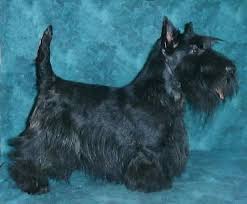 The Scottish Terrier, often called the "Scottie," is best recognized
for its distinctive profile and hard, wiry, weather-resistant outer
coat in a black, brindle or wheaten color. Its beard, eyebrows, legs
and lower body furnishings are traditionally shaggy. Like many breeds
in the Terrier Group, Scotties are small yet strong and known as fast,
alert and playful dogs. The Scottish Terrier is the only breed of dog
that has lived in the White House three times, with Presidents
Roosevelt, Eisenhower and George W. Bush.
The Scottish Terrier, often called the "Scottie," is best recognized
for its distinctive profile and hard, wiry, weather-resistant outer
coat in a black, brindle or wheaten color. Its beard, eyebrows, legs
and lower body furnishings are traditionally shaggy. Like many breeds
in the Terrier Group, Scotties are small yet strong and known as fast,
alert and playful dogs. The Scottish Terrier is the only breed of dog
that has lived in the White House three times, with Presidents
Roosevelt, Eisenhower and George W. Bush.
General Appearance
The Scottish Terrier is a small, compact, short-legged, sturdily-built dog of good bone and substance. His head is long in proportion to his size. He has a hard, wiry, weather-resistant coat and a thick-set, cobby body which is hung between short, heavy legs. These characteristics, joined with his very special keen, piercing, "varminty" expression, and his erect ears and tail are salient features of the breed. The Scottish Terrier's bold, confident, dignified aspect exemplifies power in a small package.
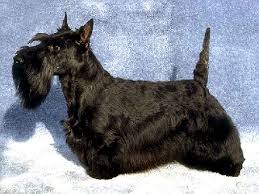 Size, Proportion, Substance
Size, Proportion, Substance
The Scottish Terrier should have a thick body and heavy bone. The principal objective must be symmetry and balance without exaggeration. Equal consideration shall be given to height, weight, length of back and length of head. Height at withers for either sex should be about 10 inches. The length of back from withers to set-on of tail should be approximately 11 inches. Generally, a well-balanced Scottish Terrier dog should weigh from 19 to 22 pounds and a bitch from 18 to 21 pounds.
Head
The head should be long in proportion to the overall length and size of the dog. In profile, the skull and muzzle should give the appearance of two parallel planes. The skull should be long and of medium width, slightly domed and covered with short, hard hair. In profile, the skull should appear flat. There should be a slight but definite stop between the skull and muzzle at eye level, allowing the eyes to be set in under the brow, contributing to proper Scottish Terrier expression. The skull should be smooth with no prominences or depressions and the cheeks should be flat and clean. The muzzle should be approximately equal to the length of skull with only a slight taper to the nose. The muzzle should be well filled in under the eye, with no evidence of snippiness. A correct Scottish Terrier muzzle should fill an average man's hand. The nose should be black, regardless of coat color, and of good size, projecting somewhat over the mouth and giving the impression that the upper jaw is longer than the lower. The teeth should be large and evenly spaced, having either a scissor or level bite, the former preferred. The jaw should be square, level and powerful. Undershot or overshot bites should be penalized. The eyes should be set wide apart and well in under the brow. They should be small, bright and piercing, and almond-shaped not round. The color should be dark brown or nearly black, the darker the better. The ears should be small, prick, set well up on the skull and pointed, but never cut. They should be covered with short velvety hair. From the front, the outer edge of the ear should form a straight line up from the side of the skull. The use, size, shape and placement of the ear and its erect carriage are major elements of the keen, alert, intelligent Scottish Terrier expression.
Neck, Topline, Body
The neck should be moderately short, strong, thick and muscular, blending smoothly into well laid back shoulders. The neck must never be so short as to appear clumsy. The body should be moderately short with ribs extending well back into a short, strong loin, deep flanks and very muscular hindquarters. The ribs should be well sprung out from the spine, forming a broad, strong back, then curving down and inward to form a deep body that would be nearly heart-shaped if viewed in cross-section. The topline of the back should be firm and level. The chest should be broad, very deep and well let down between the forelegs. The forechest should extend well in front of the legs and drop well down into the brisket. The chest should not be flat or concave, and the brisket should nicely fill an average man's slightly-cupped hand. The lowest point of the brisket should be such that an average man's fist would fit under it with little or no overhead clearance. The tail should be about seven inches long and never cut. It should be set on high and carried erectly, either vertical or with a slight curve forward, but not over the back. The tail should be thick at the base, tapering gradually to a point and covered with short, hard hair.
Forequarters
The shoulders should be well laid back and moderately well knit at the withers. The forelegs should be very heavy in bone, straight or slightly bent with elbows close to the body, and set in under the shoulder blade with a definite forechest in front of them. Scottish Terriers should not be out at the elbows. The forefeet should be larger than the hind feet, round, thick and compact with strong nails. The front feet should point straight ahead, but a slight "toeing out" is acceptable. Dew claws may be removed.
Hindquarters
The thighs should be very muscular and powerful for the size of the dog with the stifles well bent and the legs straight from hock to heel. Hocks should be well let down and parallel to each other.
Coat
The Scottish Terrier should have a broken coat. It is a hard, wiry outer coat with a soft, dense undercoat. The coat should be trimmed and blended into the furnishings to give a distinct Scottish Terrier outline. The dog should be presented with sufficient coat so that the texture and density may be determined. The longer coat on the beard, legs and lower body may be slightly softer than the body coat but should not be or appear fluffy.
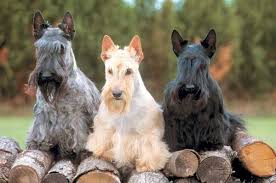 Color
Color
Black, wheaten or brindle of any color. Many black and brindle dogs have sprinklings of white or silver hairs in their coats which are normal and not to be penalized. White can be allowed only on the chest and chin and that to a slight extent only.
Gait
The gait of the Scottish Terrier is very characteristic of the breed. It is not the square trot or walk desirable in the long-legged breeds. The forelegs do not move in exact parallel planes; rather, in reaching out, the forelegs incline slightly inward because of the deep broad forechest. Movement should be free, agile and coordinated with powerful drive from the rear and good reach in front. The action of the rear legs should be square and true and, at the trot, both the hocks and stifles should be flexed with a vigorous motion. When the dog is in motion, the back should remain firm and level.
Penalties
Soft coat; curly coat; round, protruding or light eyes; overshot or undershot jaws; obviously oversize or undersize; shyness or timidity; upright shoulders; lack of reach in front or drive in rear; stiff or stilted movement; movement too wide or too close in rear; too narrow in front or rear; out at the elbow; lack of bone and substance; low set tail; lack of pigment in the nose; coarse head; and failure to show with head and tail up are faults to be penalized.
NO JUDGE SHOULD PUT TO WINNERS OR BEST OF BREED ANY SCOTTISH TERRIER NOT SHOWING REAL TERRIER CHARACTER IN THE RING.
Scale of Points
Approved October 12, 1993
Effective November 30, 1993
Two genetic health concerns seen in the breed are von Willebrand disease (vWD) and craniomandibular osteopathy (CMO); Scottie cramp, patellar luxation and cerebellar abiotrophy are also sometimes seen in this breed. Common eye conditions seen in a variety of breeds such as cataracts and glaucoma can appear in Scotties as they age. There are no specific conditions relating the skin that affect the breed, but they can be affected by common dog related conditions such as parasites and mange. Scotties typically live from 11 and 13 years. Scottish Terriers have a greater chance of developing some cancers than other purebreds. According to research by the Veterinary Medical Data Program (1986), six cancers that Scotties appeared to be more at risk for (when compared to other breeds) are: (in descending order) bladder cancer and other transitional cell carcinomas of the lower urinary tract; malignant melanoma; gastric carcinoma; squamous cell carcinoma of the skin; lymphosarcoma and nasal carcinoma. Other cancers that are known to commonly affect Scotties include mast cell sarcoma and hemangiosarcoma.
Research has suggested that Scottish Terriers are 20 times more likely to get bladder cancer than other breeds and the most common kind of bladder cancer is transitional cell carcinoma of the bladder (TCC). Dr. Deborah Knapp of Purdue University School of Veterinary Medicine has commented "TCC usually occurs in older dogs (average age 11 years) and is more common in females (2:1 ratio of females to males). Symptoms of TCC are blood in the urine, straining to urinate, and frequent urination — although owners noticing any of these symptoms should also be aware that the same symptoms may also be indicative of a urinary tract infection.
The most common and effective form of treatment for TCC is Piroxicam, a non-steroidal anti-inflammatory drug that "allows the cancer cells to kill themselves. In order to help prevent cancer in a dog, an owner should ensure that their dog has minimal exposure to herbicides, pesticides, solvents and cigarette smoke; use caution when treating dogs with some flea medications; provide a healthy, vitamin-rich diet (low in carbohydrates, high in vegetables) and plenty of exercise.
Scotties are territorial, alert, quick moving and feisty, perhaps even more so than other terrier breeds. The breed is known to be independent and self-assured, playful, intelligent and has been nicknamed the 'Diehard' because of its rugged nature and endless determination. The 'Diehard' nickname was originally given to it in the 19th century by George, the fourth Earl of Dumbarton. The Earl had a famous pack of Scottish Terriers, so brave that they were named “Diehards”. They were supposed to have inspired the name of his Regiment, The Royal Scots, "Dumbarton’s Diehards".
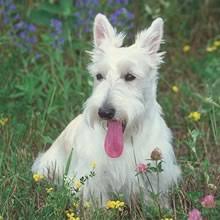 Scotties, while being described as very loving, have also been described as stubborn. They are sometimes described as an aloof breed, although it has been
noted that they tend to be very loyal to their family and are known to
attach themselves to one or two people.
Scotties, while being described as very loving, have also been described as stubborn. They are sometimes described as an aloof breed, although it has been
noted that they tend to be very loyal to their family and are known to
attach themselves to one or two people.
It has been suggested that the Scottish Terrier can make a good watchdog due to its tendency to bark only when necessary and because it is typically reserved with strangers, although this is not always the case. They have been described as a fearless breed that may be aggressive around other dogs unless introduced at an early age. Scottish Terriers were originally bred to hunt and fight badgers. Therefore, the Scottie is prone to dig as well as chase small vermin, such as squirrels, rats, and mice.The Scottish Terrier should be alert and spirited but also stable and steady-going. He is a determined and thoughtful dog whose "heads up, tails up" attitude in the ring should convey both fire and control. The Scottish Terrier, while loving and gentle with people, can be aggressive with other dogs. He should exude ruggedness and power, living up to his nickname, the "Diehard."
The Scottish Terrier as we find it today has been bred in purity for many years. The first show to have a class for Scottish Terriers was at Birmingham, England, in 1860. Later, a number of other shows carried this classification, but the dogs shown in these classes were not Scottish Terriers, but Skyes, Dandie Dinmonts, and Yorkshires.
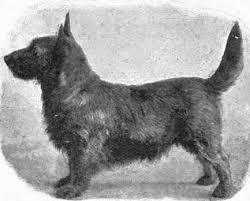 All the while, however, Scotsmen who saw these dogs winning as
Scottish Terriers were indignant, and about 1877 they broke into print
in the Live Stock Journal with a series of letters protesting the
situation and discussing the points and character of the true Scottish
Terrier. The discussion waxed so furious that the editors finally called
a halt with the statement, "We see no use in prolonging this discussion
unless each correspondent described the dog which he holds to be the
true type." This challenge was taken up by Captain Gordon Murray, who in
a letter to the Stock Keeper under the nom de plume
of "Strathbogie," described in detail his conception of a proper
Scottish Terrier. This quieted the warring factions and about 1880 J. B.
Morrison was persuaded to draw up a standard. This was accepted by all
parties.
All the while, however, Scotsmen who saw these dogs winning as
Scottish Terriers were indignant, and about 1877 they broke into print
in the Live Stock Journal with a series of letters protesting the
situation and discussing the points and character of the true Scottish
Terrier. The discussion waxed so furious that the editors finally called
a halt with the statement, "We see no use in prolonging this discussion
unless each correspondent described the dog which he holds to be the
true type." This challenge was taken up by Captain Gordon Murray, who in
a letter to the Stock Keeper under the nom de plume
of "Strathbogie," described in detail his conception of a proper
Scottish Terrier. This quieted the warring factions and about 1880 J. B.
Morrison was persuaded to draw up a standard. This was accepted by all
parties.
The essentials of this standard have been retained in all the later standards, only minor changes having been introduced. In 1882 the Scottish Terrier Club was organized with joint officers for England and Scotland. Later, as interest in the breed grew, the two countries organized separate clubs, although they have always worked harmoniously together.
 John Naylor is credited with being the first to introduce the
Scottish Terrier to this country; his initial importation in 1883 was of
a dog and a bitch, "Tam Glen" and "Bonnie Belle." He showed extensively
and continued importing, among his later importations being his famous
dogs "Glenlyon" and "Whinstone." The first Scottish Terrier registered
in America was "Dake" (3688), a brindle dog whelped September 15, 1884,
bred by 0. P. Chandler of Kokomo, Indiana. His sire was Naylor's
Glenlyon. This was in the American Kennel Register, published by Forest and Stream,
at about the time the American Kennel Club was being organized. In
December 1887, a bitch "Lassie" was registered, bred by W. H. Todd of
Vermilion, Ohio. Her sire was "Glencoe," by "Imp. Whinstone ex.
Imp. Roxie." Here we find Whinstone figuring as a sire. Now Whinstone
was by "Allister," which together with "Dundee" formed the two great
fountainheads of the breed. Whinstone sired CH. Bellingham Baliff which
was acquired by J. J. Litde, founder of the famous Newcastle Kennels.
Whinstone therefore was the forerunner and progenitor of the Scottish
Terrier in this country today.
John Naylor is credited with being the first to introduce the
Scottish Terrier to this country; his initial importation in 1883 was of
a dog and a bitch, "Tam Glen" and "Bonnie Belle." He showed extensively
and continued importing, among his later importations being his famous
dogs "Glenlyon" and "Whinstone." The first Scottish Terrier registered
in America was "Dake" (3688), a brindle dog whelped September 15, 1884,
bred by 0. P. Chandler of Kokomo, Indiana. His sire was Naylor's
Glenlyon. This was in the American Kennel Register, published by Forest and Stream,
at about the time the American Kennel Club was being organized. In
December 1887, a bitch "Lassie" was registered, bred by W. H. Todd of
Vermilion, Ohio. Her sire was "Glencoe," by "Imp. Whinstone ex.
Imp. Roxie." Here we find Whinstone figuring as a sire. Now Whinstone
was by "Allister," which together with "Dundee" formed the two great
fountainheads of the breed. Whinstone sired CH. Bellingham Baliff which
was acquired by J. J. Litde, founder of the famous Newcastle Kennels.
Whinstone therefore was the forerunner and progenitor of the Scottish
Terrier in this country today.
Since those days there have been thousands of importations and many notable breeders have carried on the work. Probably none of the early blood is to be found today Nevertheless, these early dogs must take their place in history; and to that pioneer breeder and missionary of the breed, John Naylor, the great popularity of this staunch little breed today stands as an enduring monument.

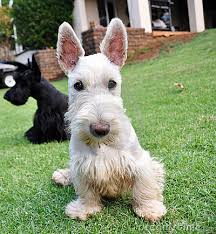

Scottish Terrier AKC Breed Standards
General Appearance
The Scottish Terrier is a small, compact, short-legged, sturdily-built dog of good bone and substance. His head is long in proportion to his size. He has a hard, wiry, weather-resistant coat and a thick-set, cobby body which is hung between short, heavy legs. These characteristics, joined with his very special keen, piercing, "varminty" expression, and his erect ears and tail are salient features of the breed. The Scottish Terrier's bold, confident, dignified aspect exemplifies power in a small package.
The Scottish Terrier should have a thick body and heavy bone. The principal objective must be symmetry and balance without exaggeration. Equal consideration shall be given to height, weight, length of back and length of head. Height at withers for either sex should be about 10 inches. The length of back from withers to set-on of tail should be approximately 11 inches. Generally, a well-balanced Scottish Terrier dog should weigh from 19 to 22 pounds and a bitch from 18 to 21 pounds.
Head
The head should be long in proportion to the overall length and size of the dog. In profile, the skull and muzzle should give the appearance of two parallel planes. The skull should be long and of medium width, slightly domed and covered with short, hard hair. In profile, the skull should appear flat. There should be a slight but definite stop between the skull and muzzle at eye level, allowing the eyes to be set in under the brow, contributing to proper Scottish Terrier expression. The skull should be smooth with no prominences or depressions and the cheeks should be flat and clean. The muzzle should be approximately equal to the length of skull with only a slight taper to the nose. The muzzle should be well filled in under the eye, with no evidence of snippiness. A correct Scottish Terrier muzzle should fill an average man's hand. The nose should be black, regardless of coat color, and of good size, projecting somewhat over the mouth and giving the impression that the upper jaw is longer than the lower. The teeth should be large and evenly spaced, having either a scissor or level bite, the former preferred. The jaw should be square, level and powerful. Undershot or overshot bites should be penalized. The eyes should be set wide apart and well in under the brow. They should be small, bright and piercing, and almond-shaped not round. The color should be dark brown or nearly black, the darker the better. The ears should be small, prick, set well up on the skull and pointed, but never cut. They should be covered with short velvety hair. From the front, the outer edge of the ear should form a straight line up from the side of the skull. The use, size, shape and placement of the ear and its erect carriage are major elements of the keen, alert, intelligent Scottish Terrier expression.
Neck, Topline, Body
The neck should be moderately short, strong, thick and muscular, blending smoothly into well laid back shoulders. The neck must never be so short as to appear clumsy. The body should be moderately short with ribs extending well back into a short, strong loin, deep flanks and very muscular hindquarters. The ribs should be well sprung out from the spine, forming a broad, strong back, then curving down and inward to form a deep body that would be nearly heart-shaped if viewed in cross-section. The topline of the back should be firm and level. The chest should be broad, very deep and well let down between the forelegs. The forechest should extend well in front of the legs and drop well down into the brisket. The chest should not be flat or concave, and the brisket should nicely fill an average man's slightly-cupped hand. The lowest point of the brisket should be such that an average man's fist would fit under it with little or no overhead clearance. The tail should be about seven inches long and never cut. It should be set on high and carried erectly, either vertical or with a slight curve forward, but not over the back. The tail should be thick at the base, tapering gradually to a point and covered with short, hard hair.
Forequarters
The shoulders should be well laid back and moderately well knit at the withers. The forelegs should be very heavy in bone, straight or slightly bent with elbows close to the body, and set in under the shoulder blade with a definite forechest in front of them. Scottish Terriers should not be out at the elbows. The forefeet should be larger than the hind feet, round, thick and compact with strong nails. The front feet should point straight ahead, but a slight "toeing out" is acceptable. Dew claws may be removed.
Hindquarters
The thighs should be very muscular and powerful for the size of the dog with the stifles well bent and the legs straight from hock to heel. Hocks should be well let down and parallel to each other.
Coat
The Scottish Terrier should have a broken coat. It is a hard, wiry outer coat with a soft, dense undercoat. The coat should be trimmed and blended into the furnishings to give a distinct Scottish Terrier outline. The dog should be presented with sufficient coat so that the texture and density may be determined. The longer coat on the beard, legs and lower body may be slightly softer than the body coat but should not be or appear fluffy.
Black, wheaten or brindle of any color. Many black and brindle dogs have sprinklings of white or silver hairs in their coats which are normal and not to be penalized. White can be allowed only on the chest and chin and that to a slight extent only.
Gait
The gait of the Scottish Terrier is very characteristic of the breed. It is not the square trot or walk desirable in the long-legged breeds. The forelegs do not move in exact parallel planes; rather, in reaching out, the forelegs incline slightly inward because of the deep broad forechest. Movement should be free, agile and coordinated with powerful drive from the rear and good reach in front. The action of the rear legs should be square and true and, at the trot, both the hocks and stifles should be flexed with a vigorous motion. When the dog is in motion, the back should remain firm and level.
Penalties
Soft coat; curly coat; round, protruding or light eyes; overshot or undershot jaws; obviously oversize or undersize; shyness or timidity; upright shoulders; lack of reach in front or drive in rear; stiff or stilted movement; movement too wide or too close in rear; too narrow in front or rear; out at the elbow; lack of bone and substance; low set tail; lack of pigment in the nose; coarse head; and failure to show with head and tail up are faults to be penalized.
NO JUDGE SHOULD PUT TO WINNERS OR BEST OF BREED ANY SCOTTISH TERRIER NOT SHOWING REAL TERRIER CHARACTER IN THE RING.
Scale of Points
| Skull Muzzle Eyes Ears Neck Chest Body Legs and Feet Tail Coat Size General Appearance Total |
5
5 5 10 5 5 15 10 5 15 10 10 100 |
Effective November 30, 1993
Scottish Terrier Health Issues
Two genetic health concerns seen in the breed are von Willebrand disease (vWD) and craniomandibular osteopathy (CMO); Scottie cramp, patellar luxation and cerebellar abiotrophy are also sometimes seen in this breed. Common eye conditions seen in a variety of breeds such as cataracts and glaucoma can appear in Scotties as they age. There are no specific conditions relating the skin that affect the breed, but they can be affected by common dog related conditions such as parasites and mange. Scotties typically live from 11 and 13 years. Scottish Terriers have a greater chance of developing some cancers than other purebreds. According to research by the Veterinary Medical Data Program (1986), six cancers that Scotties appeared to be more at risk for (when compared to other breeds) are: (in descending order) bladder cancer and other transitional cell carcinomas of the lower urinary tract; malignant melanoma; gastric carcinoma; squamous cell carcinoma of the skin; lymphosarcoma and nasal carcinoma. Other cancers that are known to commonly affect Scotties include mast cell sarcoma and hemangiosarcoma.
Research has suggested that Scottish Terriers are 20 times more likely to get bladder cancer than other breeds and the most common kind of bladder cancer is transitional cell carcinoma of the bladder (TCC). Dr. Deborah Knapp of Purdue University School of Veterinary Medicine has commented "TCC usually occurs in older dogs (average age 11 years) and is more common in females (2:1 ratio of females to males). Symptoms of TCC are blood in the urine, straining to urinate, and frequent urination — although owners noticing any of these symptoms should also be aware that the same symptoms may also be indicative of a urinary tract infection.
The most common and effective form of treatment for TCC is Piroxicam, a non-steroidal anti-inflammatory drug that "allows the cancer cells to kill themselves. In order to help prevent cancer in a dog, an owner should ensure that their dog has minimal exposure to herbicides, pesticides, solvents and cigarette smoke; use caution when treating dogs with some flea medications; provide a healthy, vitamin-rich diet (low in carbohydrates, high in vegetables) and plenty of exercise.
Scottish Terrier Temperament
Scotties are territorial, alert, quick moving and feisty, perhaps even more so than other terrier breeds. The breed is known to be independent and self-assured, playful, intelligent and has been nicknamed the 'Diehard' because of its rugged nature and endless determination. The 'Diehard' nickname was originally given to it in the 19th century by George, the fourth Earl of Dumbarton. The Earl had a famous pack of Scottish Terriers, so brave that they were named “Diehards”. They were supposed to have inspired the name of his Regiment, The Royal Scots, "Dumbarton’s Diehards".
It has been suggested that the Scottish Terrier can make a good watchdog due to its tendency to bark only when necessary and because it is typically reserved with strangers, although this is not always the case. They have been described as a fearless breed that may be aggressive around other dogs unless introduced at an early age. Scottish Terriers were originally bred to hunt and fight badgers. Therefore, the Scottie is prone to dig as well as chase small vermin, such as squirrels, rats, and mice.The Scottish Terrier should be alert and spirited but also stable and steady-going. He is a determined and thoughtful dog whose "heads up, tails up" attitude in the ring should convey both fire and control. The Scottish Terrier, while loving and gentle with people, can be aggressive with other dogs. He should exude ruggedness and power, living up to his nickname, the "Diehard."
Did You Know?
- The Scottish Terrier was bred in Scotland as a fierce hunter of foxes and badgers.
- The first show to have a class for the Scottish Terrier was in 1860.
- John Naylor is credited with being the first to introduce the Scottie to this country.
- The first registered Scottie in America was "Dake," whelped Sept. 15, 1884.
- Franklin D. Roosevelt's Scottish Terrier "Fala" reportedly received more fan mail than many presidents did.
- Dwight D. Eisenhower owned two Scottish Terriers named "Caacie" and "Telek."
Scottish Terrier History
The Scottish Terrier as we find it today has been bred in purity for many years. The first show to have a class for Scottish Terriers was at Birmingham, England, in 1860. Later, a number of other shows carried this classification, but the dogs shown in these classes were not Scottish Terriers, but Skyes, Dandie Dinmonts, and Yorkshires.
The essentials of this standard have been retained in all the later standards, only minor changes having been introduced. In 1882 the Scottish Terrier Club was organized with joint officers for England and Scotland. Later, as interest in the breed grew, the two countries organized separate clubs, although they have always worked harmoniously together.
Since those days there have been thousands of importations and many notable breeders have carried on the work. Probably none of the early blood is to be found today Nevertheless, these early dogs must take their place in history; and to that pioneer breeder and missionary of the breed, John Naylor, the great popularity of this staunch little breed today stands as an enduring monument.
Scottish Terrier Pics
AKC Registered Breeders
Scottish Terrier
Parent Club: Scottish Terrier Club of America
Breeder Referral: Ann Frankewich; frankewich@aol.com
Regional Clubs: website
Parent Club: Scottish Terrier Club of America
Breeder Referral: Ann Frankewich; frankewich@aol.com
Regional Clubs: website